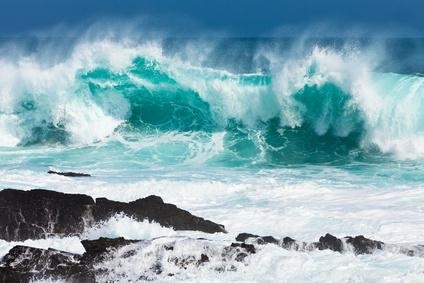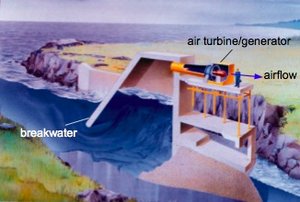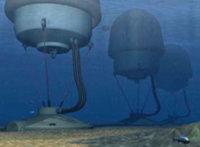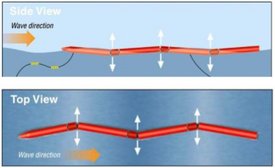Wave power (About the EoE)
Contents
Wave power
Wave power refers to the the energy in the surface of water waves, or from pressure changes just below the surface of waves, that can be harnessed to generate electricity. Wave power is not widely used, but there is considerable research being done into how to harvest wave power as a renewable energy source. Only one system is currently being used commercially, but there are multiple other devices being used for demonstration and research purposes.
Physics
Wave energy is a potential renewable source of energy because energy can be harvested from waves and converted into electrical power used to do work. Waves are generated by wind passing over the sea surface. Wave power is also determined by wave speed, wavelength, and water density. The potential power from a wave is summarized by the following equation relating the density of seawater, acceleration due to gravity, period of the wave, and wave height:
P = ρg2TH2/32π
where
ρ = the density of seawater = 1,025 kg/m3,
g = acceleration due to gravity = 9.8 m/s/s,
T = period of wave (s),
and H = wave height (m)
This equation provides a value for the power generated from a wave in terms of Watts per meter (W/m) and gives a numerical prediction for the efficiency of waves in different areas, which have different values for the variables in this equation due to environment. Power is also sometimes represented in watt-hours, which is the number of watts produced in an hour. Energy consumption is often measured in kilowatt-hours per year (kWh/y). If a system were to produce 1 Watt of power for an entire year, it would produce about 1300 kWh based on the following: 1 J-s-1 x (3600 s/hr) x (365 days/year) = 1314 kWh/y.
Potential Wave Power Resource
As waves approach the shore, the energy of the waves dissipates, so there is less potential energy to be harvested. Wave energy converters are more efficient than solar or wind energy converters: wave energy converters have a conversion efficiency of about 80%, while solar converters are at 35% and wind converters are at 50%. The north and south temperate zones have the greatest potential for wave power.
In these regions, winds blow hardest in winter, causing the wave energy potential to be greatest during this time. This is an extra benefit of wave power because electricity consumption is highest during the winter. There is a wide range of estimates for the actual potential of wave power, but the largest estimated potentials are contained in the following table. The units are in kilowatts per meter of coastline.
|
Location |
Estimated Wave Power Potential (kW/m) |
|
United Kingdom |
45-75 |
|
Canada |
33 |
|
Ireland |
57-77 |
|
Portugal |
30-40 |
|
France |
44-45 |
|
Norway |
20-40 |
|
USA: California |
10-32 |
|
USA: Oregon |
21 |
Most estimates of the total wave power resource are around 2 TW (2 x 109 kilowatts). This is equivalent to about 2.6 x 1015 kWh/y. However, there are a wide range of estimates for the portion of this that is economically feasible to harvest. These estimates range from 140-2000 TWh/y. Most of this range is dependent on the extent to which technologies improve. For comparison, global electricity use is about 18000 TWh/y. Based on these numbers, it is apparent that although wave power could not account for all electricity usage, it could account a significant portion of it.
Wave power technology
There are many different ways to categorize wave power devices, such as based on the technology of the machine, but location relative to the shore is the most basic way to categorize them. They can be on the shoreline, the ocean bottom, or on the ocean surface. Some of these devices also have an on-shore component associated with them as well. Although about 40 different devices have been proposed, only some of the more common devices will be covered.
Shoreline
Oscillating Water Column
A breakwater is projected into the water. As a wave comes in, it pushes the water behind the breakwater up, causing the air pressure in the air pocket to change. This causes a turbine to spin, and when the wave goes out the air depression also causes the turbine to spin, both producing electricity.
A Case Study: The Limpet
The Limpet 500 (Land Installed Marine Power Energy Transformer), a wave power generator located on the island of Islay, Scotland, is the world’s first commercial wave power station. The Limpet consists of a wave energy collector as well as a generator to turn this energy from waves into usable electricity. The energy collector works because it compresses the air in the top of an air chamber as waves enter the shell chamber and then forces this air into a turbine. As waves flow back and forth, the air is sucked back into the chamber, a motion that keeps the turbine moving. The turbine’s movement in turn drives the generator which converts this wave energy into electricity. The performance of this wave power generator has been optimized to a maximum potential output of 500 kW because the turbine drives two 250 kW generators.
Pendulum System
A giant concrete box is installed at the shoreline with a big, thick pendulum flap across the opening of the box towards the waves. The waves come in and push the pendulum flap backwards, and then as the waves come out, the pendulum is pushed in the other direction. The back and forth motion powers a hydraulic pump, which then generates electricity.
Nearshore
Offshore Wave Dragon
This was the world's first nearshore wave power device that actually produced power for the electrical grid. These systems can be found as single units, or as part of huge wave farms. A group of 200 of these devices can create power approximately equivalent to that of a traditional fossil fuel power plant. An Offshore Wave Dragon has two arms that guide waves up onto a platform above the sea surface, which then either go across the gap to the reservoir, or go straight down through the gap and turn a turbine, which generates electricity. The reservoir basically just stores ocean water on the other side of the gap, and it deposits water through the gap to produce electricity as well. The whole device floats, which makes maintenance and repair easier and less expensive.
Power Buoy
These devices are basically buoys that rise and fall with the ocean, and they convert this mechanical energy from the motion of waves to electricity, which is transported to the shore through undersea wires. A buoy that produces about 40 kW of power has a diameter of about 4 m and is about 16 m long. Only about 5 m of the buoy stays above the surface of the water. It uses the three-point mooring system and are generally installed about 8 km offshore in water that is 40-60 m deep.
Offshore
Salter's Duck System
This system was produced in response to the Oil Crisis of 1973. It can be positioned up to 80 km off of the coast. Even though was projected to have a very high theoretical efficiency, there were cost associated problems with it, which subsequently caused the device to have never actually made it out to sea. In the 1980s, a report by the European Union evaluating the cost of Salter's Duck miscalculated the cost of the system by a factor of ten, halting efforts to use the device for harvesting power from waves. Salter's duck operates by absorbing 90% of the energy from incoming waves, using the nodding motion of the device to compress hydraulic oil. Once the pressure of this oil has built up, it is released through a motor that converts the power from waves to electricity. Since earlier efforts to use Salter's duck were once halted, the potential of the device is still fairly unknown.
Pelamis Wave Energy Converter
The Pelamis Wave Energy Converter is an example of a type of device called an attenuator, which is a long multi-segment structure that is parallel to the direction of wave travel. The spots along the device where the segments are connected are in turn connected to hydraulic pumps or other converters which then harvest wave power. The Pelamis Wave Energy Converter has four 30-m long by 3.5-m diameter floating cylindrical pontoons connected by three hinged joints. A four-segment production was tested for 1000 hours in 2004 and was rated at 750 kW. The Pelamis Wave Energy Converter in Portugal was an early type of wave farm that was successful in generating wave power. Other sites were tested with the following rates of efficiency and potential: off the coasts of Hawaii (15.2 kW/m average annual wave energy), Oregon (21.2 kW/m), California (11.2 kW/m), Massachusetts (13.8 kW/m), and Maine (4.9 kW/m).
Wave Roller System
The Wave Roller System consists of a plate lying on the bottom of the sea which moves back and forth in way that is consistent with the motion of waves. It then collects this movement into a piston which in turn compresses oil to power a hydraulic motor. This then powers an electrical generator that converts the energy from waves into electrical energy. There is a very low environmental impact and the plates used are usually of 15 kW.
The Archimedes Wave Swing
The Archimedes Wave Swing is a cylinder shaped buoy on the seabed that converts the up and down movement of passing waves to electricity. The power-absorption concept has been proven at full-scale in 2004 via a pilot plant that was installed off the coast of Portugal. The Archimedes Wave Swing takes up a relatively small area of the sea compared to the power it generates and also has a high power density, making it more resistant to environmental disturbances and therefore a favorable wave power device.
Bristol Cylinder
The Bristol Cylinder is a floating cylinder that is mechanically connected to an energy unit via rods that transfer this movement to the axles in a converter unit called an Escone, which works with the oscillating movement of waves. This converts the motion to a rotating shaft that is in turn connected to a generator that creates electrical energy. The Bristol Cylinder also operates under the sea surface.
Current Status
While there are a number of different devices currently in the trial process or operating as demonstration devices, there is only one commercially operating wave power plant in the world as of now, the LIMPET in Scotland. The LIMPET has a maximum output of 500 kW . The world's first commercially operating wave farm, which simply means that it has more than one single device, had three Pelamis units operating in Aguçadoura, Portugal beginning in fall of 2008. A plan was made to add 25 more converters but was then halted after all three Pelamis units had to be removed due to technical difficulty. The three Pelamis units were removed as a result of leaks in the buoyancy tanks of the devices. Other technical problems arose, and the financial crisis caused some of the financial backers to pull out, which has prevented the devices from being re-deployed even after the technical issue was corrected. It had a maximum output of 2.25 MW.
The Oyster is a new machine that has the potential to harness more energy from waves. The oyster is composed of an 18m wide oscillator that also has pistons attached to it. The oscillator responds to the movement of waves by pushing high-pressure water to the shore where generators convert the energy from waves into electrical energy. The main difference between the Oyster and other generators is that it requires no underwater component and can be operated using only an onshore component. Therefore, the Oyster is designed mostly for nearshore usage. However, developments are still occurring and could be employed in areas such as the North West coast of the USA and coastlines off South Africa, Australia, and Chile.
Economics
The economic success of wave power depends mainly on the degree to which the power produced by the plants gets used, and the price at which the electricity can be sold. Since wave power is so variable, it is difficult to get a general consensus on if wave power is, or will be, economically successful without subsidies. The main things that need to be considered when investing in a wave power device are the marketplace prices, the interest rate, and the degree of utilization. The one thing that is certain is that costs have come down over time with further research and development. The present world-capacity for wave power is 1 MW, but this is mostly from demonstration devices. This value is projected to increase in the future. The potential contribution of wave energy to world-wide electricity consumption is about 10%, at 2000 TWh/year. To reach this maximum potential, it is estimated that the original investment cost will be 820 billion EUR, and the predicted electricity generating cost will be 0.08 EUR/kWh.
Environmental Impacts
Wave power devices can affect coastal tourism and recreation as obtrusive generators and converters could take away from the appeal of a location’s natural environment. For instance, oscillating water columns are visually obtrusive and overtopping devices are as well because they are floating platforms on the ocean. In addition to the alteration of a location’s natural appeal, noise pollution could also be an environmental impact. Noise generated by the movement of various wave energy devices has the potential to affect residents of areas where such devices exist. For instance, the noise generated from the movement of the oscillating water column drawing air in and out would be the loudest source of noise, but turbines, water pumps, and other harvesting devices could generate noise. Marine habitat also stands to be affected by wave power devices, yet it is not completely clear how habitats will respond. It is important to monitor how aquatic organisms respond to devices that are submerged in water and that other organisms, such as seals and birds could make above-water devices their new habitat. If the locations for wave energy converters are not carefully selected, competition could occur with other sea space users such as commercial shipping and fishing because the space which is normally used for such activities is now obstructed by a device. The release of toxic liquids from hydraulic fluids into the environment is another area of concern because such an event could be detrimental to living organisms in the area surrounding the device. While these are all potential environmental concerns associated with wave power devices, it is still relatively unknown as to how exactly wave power devices will affect the areas in which they operate.
Challenges and Limits to Further Expansion
The systems must be able to withstand rough weather. An example of a system that have failed due to wave storms is the Osprey in Scotland, which broke before installation could be completed. The amount of wave energy harvested by a system depends on the intensity of the waves, which needs to be consistent for the greatest efficiency to be achieved. At this point, the second generation of wave power devices are still being researched at universities. In the near future, only shoreline and nearshore devices have the potential to be useful because of the cost in transporting the energy from far out in the ocean to land. The largest wave energy potential lies away from the shoreline, which means the electricity produced out in the ocean would have to be transported long distances, so the electrical grid would have to be expanded to include this power from waves. At the moment, the cost to produce a kilowatt-hour is greater through wave power than through other more conventional forms of power production. It is a costly investment to build and install a wave power device, but with developing technologies the price could come down.
Another challenge that wave power has faced is as a result of possible environmental hazards that affect commercial activities such as fishing. Pacific Gas & Electric is one such company that planned two 40-megawatt wave farms for the Northern California coast yet chose to drop one of them. These wave farms were to be located off the coast of the Humboldt and Mendocino counties in the Pacific Ocean yet the Mendocino project was abandoned because Pacific Gas & Electric was not permitted to buy part of a wave farm. The Humboldt project is also facing difficulties as a result of The National Marine Fisheries Service’s concern that species such as the elephant seal and other aquatic creatures will be affected. Thus, the projects for wave farms near Northern California have faced a few setbacks.
Note: This article was researched and written by a student at Boston University participating in the Encyclopedia of Earth's (EoE) Student Science Communication Project. The project encourages students in undergraduate and graduate programs to write about timely scientific issues under close faculty guidance. All articles have been reviewed by internal EoE editors, and by independent experts on each topic.
This article uses material from the Wikipedia article Wave power. The Author(s) and Topic Editor(s) associated with this article may have significantly modified the content derived from Wikipedia with original content or with content drawn from other sources. All content from Wikipedia has been reviewed and approved by those Author(s) and Topic Editor(s), and is subject to the same peer review process as other content in the EoE. The current version of the Wikipedia article may differ from the version that existed on the date of access. This article is licensed under the GNU Free Documentation License 1.2. See the EoE’s Policy on the Use of Content from Wikipedia for more information.
Sources
1: Wave Power, Encyclopedia of Coastal Science, 2005.
2: Thorpe, T.W., Economic Analysis of Wave Power Devices, AEA Technology, 1998.
3: Davies, P.A., Wave-powered desalination: resource assessment and review of technology, Desalination, Volume 186, Issues 1-3, December 2005, Pages 97-109.
4: Rodrigues, L., Wave Power conversion systems for electrical energy production, Nova University of Lisbon.
5: Technology White Paper on Wave Energy Potential on the US Outer Continental Shelf, Renewable Energy and Alternate Use Program U.S. Department of the Interior, 2006.
6: Archimedes Waveswing, AWS Ocean Energy, accessed 11 November 2009.
7: Leijon, M., Bernhoff, H., et. al, Economical considerations of renewable electric energy production—especially development of wave energy, Renewable Energy, Volume 28, Issue 8, July 2003, Pages 1201-1209.
8: Petroncini, S., Introducing Wave Energy Into the Renewable Energy Marketplace, University of Edinburgh, 2000.
9. Zafer, D., Haas, K.A., and Fritz, H.M., Wave power potential along the Atlantic coast of the southeastern USA, Renewable Energy, Volume 34, Issue 10, October 2009, Pages 2197-2205.
10. Wave Power, Wikipedia, Accessed 29 October 2009.
11. Ocean Energy: Technology, European Ocean Energy Association, 2009, Accessed 12 November 2009.
12. Ed. Cruz, J., Ocean Wave Energy: Current Status and Future Perspectives, Springer, 2008, Accessed 11 November 2009.
13. Ocean Wave Power, U.S. Department of Energy, 2008, Accessed 14 November 2009.
14. Electricity Consumption per Capita, World Bank, 2009, Accessed 13 November 2009.
15. Wave, Murdoch University Research Institute for Sustainable Energy, 2008, Accessed 14 November 2009.
16. Aguçadoura, Pelamis Wave Energy, 2009, Accessed 14 November 2009.
17. Wavegen, Accessed 14 November 2009.
18. How it Works: Wave Power Station, BBC News, Accessed 14 November 2009.
19. Salter's Duck Diagram, Accessed 16 November 2009.
20. Falcao, A.F., First-Generation Wave Power Plants: Current Status and R&D Requirements, Journal of Offshore Mechanics and Arctic Engineering, Volume 126, Issue 4, November 2004, Pages 384-388.
21. Cleantech Group, Pelamis sinks Portugal wave-power project, International Herald Tribune, 17 March 2009, Accessed 2 December 2009.
22. Woody, Todd. Wave Power Setbacks in California, New York Times, 12 August 2009, Accessed 6 December 2009.
23. AlphaGalileo Foundation. Harnessing Wave Power with New "Oyster" Machine, Science Daily, 3 August 2009, Accessed 9 December 2009.
Further Reading
1. Renewable electricity politics across borders
2. Wave, Tidal, and In-Stream Energy Projects: Which Federal Agency has the Lead
3. Leijon, M., Bernhoff, H., et. al, Multiphysics Simulation of Wave Energy to Electric Energy Conversion by Permanent Magnet Linear Generator, IEEE Transactions on Energy Conversion, 2005.
4. Thorpe, T., An Overview of Wave Energy Technologies: Status, Performance, and Costs Broadway House, Westminster, England, 1999.
5. International Energy Outlook 2009 Energy Information Association: Official Energy Statistics from the U.S. Government, 2009, Accessed 12 November 2009.
</div>



